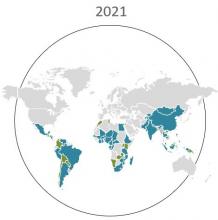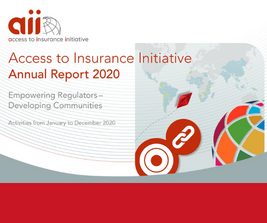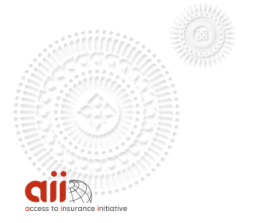Sixteen years of inclusive insurance regulation
Sixteen years of inclusive insurance regulation

The A2ii is pleased to launch its interactive Inclusive Insurance Regulations Map. It is designed to provide insight on the status of inclusive insurance regulation around the globe. We hope that it proves to be a useful and dynamic tool for supervisors, researchers, the development community and other stakeholders. The map is a live document, and we will update it regularly. We welcome regulators to submit new information about the state of inclusive insurance in their jurisdiction by emailing secretariat@a2ii.org.
It has been sixteen years since India enacted the first microinsurance regulation in 2005. Four years later, when the A2ii first compiled a map on inclusive insurance regulation, there were only six jurisdictions on the map.
In the years since, A2ii and the IAIS have drawn on the experience of these pioneering countries to promote the implementation of proportionate regulations, emphasising the balance of effective supervision, access to insurance and consumer protection. As the numbers grew, we began to see that our collection of data could serve as a public tool for learning, research and peer exchange.
Now, having passed the 11th year of the A2ii’s founding, at least 30 authorities across 43 markets have implemented dedicated inclusive insurance regulation, and others have adopted other regulatory approaches that are supportive of inclusive insurance.


By sheer numbers alone, it is clear there has been notable progress compared to the early days of microinsurance market development. Perhaps more interestingly, what has our research for the map told us about the ways in which inclusive insurance regulation has changed? Here we examine the pathways to inclusive insurance over the last sixteen years and the trends that have occurred along the way.
Many roads lead to inclusive insurance
Even by 2009, the six countries had adopted very different definitions to inclusive insurance. India and the Philippines adopted detailed quantitative definitions. India applied quantitative parameters to each product line, setting various minimum and maximum amounts of cover. The Philippines applied the parameters to all microinsurance products, setting a daily premium cap and a maximum coverage. In contrast, Chinese Taipei used a qualitative definition, focusing on the target subgroup: the ‘economically disadvantaged’ population.
Today, definitions are equally varied, with some regulators having tried different approaches over time. Although the first regulation in Peru defined quantitative parameters for all microinsurance products, a few years later a middle way was adopted. This came with the inclusion of a qualitative definition framed around the needs of low-income groups. The objective was to provide more flexibility in product development.
What has endured, however, is the firm focus on low-income and financially vulnerable groups and the need for them to protect themselves against shocks to their livelihoods.
Other supportive regulation
A dedicated inclusive insurance or microinsurance framework should not be seen as a be-all and end-all, since it is not the only way to make insurance markets more inclusive. In fact, some markets have shown that creating new dedicated frameworks runs the risk of regulatory arbitrage[1].
As an example, Colombia is one case of a country that supports inclusive insurance through the regulatory provisions used by traditional insurance and by a focus on financial inclusion and innovation, but not with a dedicated framework.
For this reason, we have also included information under the category 'Other supportive regulation' in the map. This category covers a myriad of different approaches making insurance more accessible and inclusive such as: enabling use of remote means, digital models, and e-signatures in insurance operations; mobile insurance; regulatory sandboxes; insurance against climate risks and disasters; agriculture insurance; and index insurance, among other innovations and trends.
Index insurance
Although not yet mainstream in insurance regulations, index insurance, or parametric insurance, is receiving recognition in various jurisdictions[2]. It can be used to provide insurance services to excluded or underserved segments that would otherwise not be able to obtain protection against the risks they face. It fixes a payout to a certain pre-defined trigger thus reducing the costs of administrating a claim and potentially making insurance more affordable. A range of inclusive examples can be found among jurisdictions that have implemented frameworks, or have them in the works, particularly when it comes to climate and disaster risks and risks faced by the agricultural sector.
Kenya is one of the first countries to include a definition of index insurance in their legislation, in addition to the definition of microinsurance. Argentina has index-based agricultural insurance, and Mongolia has a law in place on index-based livestock insurance for herders.
One of the newest developments comes from Puerto Rico, which is often hit by devastating hurricanes. In July 2020, regulations were issued on parametric catastrophic microinsurance in personal lines. Encouragingly, we have also learned that Ethiopia intends to develop a framework for weather index insurance.
For all interested stakeholders, the A2ii plans to hold a public dialogue on Index Insurance in March 2021, aligned with an upcoming paper based on the results of the A2ii 2020 Index Insurance survey.
Tech-driven models
Today, inclusive insurance markets are changing due to technology-driven trends in distribution and product innovation, and regulations have been increasingly responding in kind. Recent examples include Egypt, which issued directives for the electronic issuing and distribution of microinsurance policies in 2016. The year after, Ghana issued market conduct rules for mobile insurance. Kenya in 2019 included a stipulation that allows policy-related documents to be sent electronically. Uganda issued mobile insurance regulations in 2020, showing responsiveness to the changing landscape. Conveying this demand, in 2018, 56% of Ugandan adults already used mobile money services.
Some regulators were ahead of the curve – the Superintendência de Seguros Privados (SUSEP), Brazil’s regulatory authority, has allowed technology-neutral, remote means of selling microinsurance since 2012, opening up new possibilities such as internet-enabled models and biometric signatures.
Technology also has its pitfalls however: a learning from Brazil is that remote or electronic means tends to enable more young people, rather than older generations. In this regard, access for people of all ages should be kept in mind, in order to leave no one behind.
Supportive regulation that encourages innovation, including allowances for regulatory sandboxes, is expanding the scope of products that will be offered in the future.
Still, technology presents an opportunity to test out more financially viable ways of reaching underserved groups. Regulatory sandboxes are another way that regulators are encouraging innovations to make insurance more inclusive.
When the Securities and Exchange Commission of Pakistan issued regulatory sandbox guidelines, they included a parameter to screen applicants for proposals that increased financial inclusion. The Reserve Bank of Fiji cited the role of innovation in striving toward an improved standard of living and financial inclusion in their FinTech Regulatory Sandbox Guideline. This is clearly an on-going trend and one that extends beyond emerging markets: applications for the UK’s Financial Conduct Authority regulatory sandbox calls for products and services to demonstrate how they address issues of access and exclusion.
A renewed interest in dedicated licensing
Although the most common way of regulating microinsurance is still through the business line approach[3], there has been a renewed interest in the institutional approach of creating dedicated licensing with proportionately lighter licensing requirements. The theory is that smaller or less complex entities, such as community organisations, informal providers or new entrants (such as InsurTechs) that otherwise would not be able to meet requirements, can enter the regulated microinsurance market or formalise themselves.
The Philippines, for instance, transformed their market by rolling out licenses to operate as a Mutual Benefit Association offering microinsurance only. Japan has long had a category of ‘small amount and short-term insurers’ offering products where incumbents did not always provide coverage.
Overall, the degree of success of this approach is debatable. However, partly driven by InsurTech, this approach has regained traction.
In 2018 South Africa established a new microinsurance license category, lowering barriers to entry by reducing prudential requirements and allowing dedicated microinsurers to be profit-making, not-for-profit, or co-operatives. In 2020, the Insurance Regulatory and Development Authority of India (IRDAI) convened a committee to study standalone microinsurance companies. One concept being considered by the IRDAI committee is the cell captive model. The cell captive, a longstanding feature in insurance markets such as North America, Bermuda and the Caribbean, and South Africa, is now also being explored as a potential vehicle for inclusive insurance in several Sub-Saharan African countries.
Within challenges, new learning opportunities
Over the years, supervisors have found themselves confronted by various challenges, including formalisation, data collection, and the sustainability of state-led programs. Across all these areas, supervisors must keep proportionality in mind: balancing protecting the consumer with the need to provide an enabling regulatory environment for market growth and innovation. Technology and innovation come with advancements and efficiency, but also bring regulatory concerns.
Inclusive insurance is no longer only an issue for developing countries. Through recent political trends, climate change and natural disasters, and combined with the effects of the pandemic, social and economic inequalities have come to the fore. Despite the challenges of the last 12 months, opportunities for learning and peer exchange with supervisors from other jurisdictions are now more plentiful than ever, with virtual exchanges enabling connections across the globe.
With all that said, we are excited to present to you our interactive and searchable inclusive insurance map. Click here to explore.
[1] See box 8 in Proportionate Regulatory Frameworks in Inclusive Insurance: Lessons from a Decade of Microinsurance Regulation
[2] In our recent Index Insurance survey, at least 11 jurisdictions from our sample indicate they have included an index insurance recognition under a law or regulation in the context of inclusion. Index insurance can either be allowed through legislation or through a favorable legal interpretation (a legal opinion).
[3] This refers to a definition of ‘microinsurance’ as a product or business line, where the regulations are applied to products or business lines that match the definition.
Share this article
Also in Blog







Authors
Posts by Author
Topics Cloud
Subscribe to our list
Receive notifications when we publish new blog entries
Subscribe here



